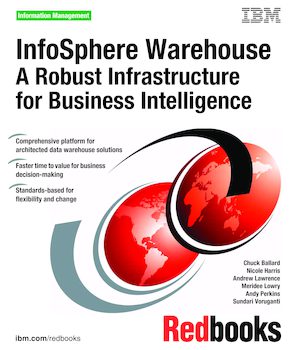InfoSphere Warehouse: A Robust Infrastructure for Business Intelligence
An IBM Redbooks publication
Note: This is publication is now archived. For reference only.

Published on 18 June 2010, updated 22 June 2010
ISBN-10: 0738434329
ISBN-13: 9780738434322
IBM Form #: SG24-7813-00
Authors: Chuck Ballard, Nicole Harris, Andrew Lawrence, Meridee Lowry, Andy Perkins and Sundari Voruganti
In this IBM® Redbooks® publication we describe and demonstrate Version 9.7 of IBM InfoSphere™ Warehouse. InfoSphere Warehouse is a comprehensive platform with all the functionality required for developing robust infrastructure for business intelligence solutions. It enables companies to access and analyze operational and historical information, whether structured or unstructured, to gain business insight for improved decision making. InfoSphere Warehouse solutions simplify the processes of developing and maintaining a data warehousing infrastructure and can significantly enhance the time to value for business analytics.
The InfoSphere Warehouse platform provides a fully integrated environment built around IBM DB2® 9.7 server technology on Linux®, UNIX® and Microsoft® Windows® platforms, as well as System z®. Common user interfaces support application development, data modeling and mapping, SQL transformation, online application processing (OLAP) and data mining functionality from virtually all types of information.
Composed of a component-based architecture, it extends the DB2 data warehouse with design-side tooling and runtime infrastructure for OLAP, data mining, inLine analytics and intra-warehouse data movement and transformation, on a common platform.
Chapter 1. Gaining business insight with InfoSphere Warehouse
Chapter 2. Technical overview of InfoSphere Warehouse
Chapter 3. InfoSphere Warehouse Design Studio
Chapter 4. Developing the physical data model
Chapter 5. Data movement and transformation
Chapter 6. InfoSphere Warehouse Cubing Services
Chapter 7. Data mining
Chapter 8. Text analytics
Chapter 9. Deploying and managing solutions
Chapter 10. Workload management
Chapter 11. Providing the analytics
Chapter 12. Case Study: InfoSphere integration on System z
Appendix A. DB2 ESE for LUW: Support for data warehousing
Appendix B. DB2 for z/OS: Support for data warehousing